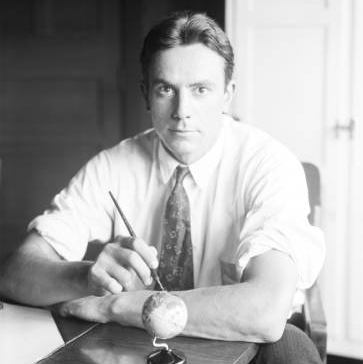
Anton “Tony” Hulman, Jr.
If not for Tony Hulman, the Indianapolis Motor Speedway would very likely not still be in existence.
Born in Terre Haute, Indiana, Tony was the grandson of a German immigrant named Herman Hulman. Herman had landed in Cincinnati, started up a wholesale grocery business, and then moved to Terre Haute. By the time Tony was ready for post-secondary education, the Hulman family was in a position to send him first to Worcester Academy and then to Yale. He graduated from Yale in 1924 with a degree in engineering from the university’s Sheffield Scientific school.
During World War I, Hulman, at the age of 17, spent part of his high school summer break in war-torn France as an ambulance driver for the Red Cross. Growing up, Tony was also very much the athlete. The Amateur Athletic Association named him the most outstanding high school pole-vaulter in the United States for 1919.
Once at Yale, Hulman continued to stand out as an athlete. He was a member of the school’s undefeated football team in 1923. In 1923 and 1924, he took part in several intercollegiate track and field meets. He even won the high hurdles event at the then-brand-new Wembley stadium in England.
Back from college, Tony went to work for the family grocery business. As his first assignment, he marketed Clabber Girl Baking Powder, a product Hulman & Company had owned for some time. He is given much credit for the subsequent success of the product. By 1931, he was Hulman & Company president.
In 1926, Tony married Mary Fendrich of Evansville, whose background was remarkably similar to his own. Her grandfather was also a German immigrant who had enjoyed considerable success in the business world. In this case, he and his brothers had started the famed La Fendrich cigar concern. A daughter, Antonia “Mari” Hulman George was born in 1934.
Joseph R. Cloutier steered Hulman & Company as treasurer for about six decades. He began acquiring a variety of diversified holdings starting in about 1938. Over the years, Hulman & Company came to encompass real estate, power and utility businesses, newspapers, radio and television stations, a brewery, and eventually several Coca Cola bottling plants, among other interests. Following World War II, Tony added the Indianapolis Motor Speedway to its assets.
Shut down for the duration of the war, the Speedway fell into a terrible state of disrepair. The locals had come to accept that, once the hostilities were over, the track would likely be razed and the ground cleared to make way for a housing development.
Shelbyville-born Wilbur Shaw, the three-time Indianapolis 500 winner—and generally the most successful of any “500” driver up to that point—spent the war years working in Akron, Ohio, for the aircraft division of Firestone Tire and Rubber company. As it became clear that the war was nearing its end, Firestone obtained permission from the government to conduct a test of a synthetic tire for passenger-car use with Shaw at the Indianapolis Motor Speedway. The track’s condition horrified Shaw.
Shaw quickly travelled to New York to meet with the track’s owner, the famed World War I flying ace, Eddie Rickenbacker, who had driven in the “500” several times before he ever learned how to fly a plane. Having determined the shuttered facility might be for sale, Shaw set out to try and find 20 partners who would join him in making the purchase, but the response was not nearly what he had sought.
After several additional setbacks, he was able to sit down with a real estate broker friend named Homer Cochran, against whom Wilbur had briefly raced dirt track cars in the early 1920s. Cochran mentioned that he had recently conducted several real estate deals with a fellow over in Terre Haute who might be worth visiting.
He was referring to Tony Hulman.
A subsequent visit proved to be most fortuitous as Hulman was more than receptive, fondly recalling attending his first “500” in 1914 at the age of 13 and then returning for numerous races thereafter. Undeterred by the condition of the facility, Hulman entered into a couple of months of intense negotiations and on November 14, 1945, came the announcement that Hulman—rather than Shaw—had become the new owner, but with Shaw to serve as president and general manager.
Largely unknown to the people of Indianapolis, Hulman generally kept a much lower profile than the dynamic and internationally known Shaw. While they did make numerous appearances together, the genial and down-to-earth Hulman seemed perfectly content to have Shaw be the “front” man. The stories are legendary about him frequently misplacing his track credentials and being nothing but courteous and understanding when a well-meaning guard would not recognize him and temporarily deny access.
After the loss of Shaw in a private aircraft accident on October 30, 1954, however, more than one racing notable saw themselves as Shaw’s successor only to be completely taken aback when Tony assumed the title of president. From that point on, he became much more visible. Among other duties, he took over the verbal command to start the race that Shaw popularized. After veteran broadcaster and band leader Luke Walton coached him, Hulman eventually developed the powerful and never-to-be-forgotten rendition, “GENNELLLMEEEEN, START YOURRRRENGINES.”
Over the decades, the Hulman family donated literally millions upon millions of dollars to charity, specifically to educational institutions, animal care, and the arts, all typically with little or no fanfare.
DONALD DAVIDSON, Chief historian for USAC and the Indianapolis Motor Speedway

